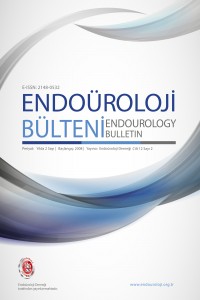Fiberoptik mi dijital mi? Böbrek taşı tedavisinde iki farklı flexible üreteroskop kullanımının karşılaştırılması
Abstract
Amaç: Böbrek taşı tedavisinde minimal invaziv yöntemlerden olan retrograd intrarenal cerrahi kullanım sahası sürekli olarak artan ve yüksek kalitede görüntü sunan dijital sistemlerin de kullanılabildiği bir yöntemdir. Bu çalışmada amacımız literatürde az sayıda bulunması nedeniyle dijital ve konvansiyonel yöntemler ile yapılan retrograd intrarenal cerrahi (RIRC) ameliyatlarının etkinliğinin, güvenilirliğinin ve maliyetinin karşılaştırılmasıdır.
Gereç ve Yöntemler: Çalışmamıza 75 hasta dahil edildi. Bunlardan 47 tanesine dijital flexible üreteroskop (fURS) ile 28 tanesine konvansiyonel flexible üreteroskop ile ameliyat yapıldı. Ameliyat öncesi demografik veriler ile taş boyutları, lokalizasyonları ve geçirilmiş cerrahiler kaydedildi. Ameliyat esnasında irrigasyon miktarı, floroskopi süresi, lazer cihazının gücü kaydedildi. Sonrasında bu hastalar postoperatif 1. gün ve 1. ayda tekrar değerlendirildi. Tam taşsızlık oranı, rezidü taşlar, komplikasyonlar değerlendirildi. İki grup arasında karşılaştırma yapıldı.
Bulgular: Hastaların dijital flexible üreteroskop grubunda olanların yaş ortalaması 42,15’di. Ortalama taş boyutları 18,89 mm ve taşların %44,7’si alt kaliks taşıydı. Konvansiyonel flexible üreteroskop grubunda yaş ortalaması 43,07 idi. Ortalama taş boyutu 17,64 mm ve taşların %46,4’ü alt kaliks taşıydı. Postoperatif yapılan analizlerde taşsızlık oranında dijital flexible üreteroskop yönünde anlamlı farklılık saptandı (p<0,05). Diğer parametrelerde anlamlı farklılık saptanmadı.
Sonuç: Literatürde operasyon süreleri açısından anlamlı farklılık varken bizim çalışmada böyle bir farklılık saptanmadı. Literatürdeki çalışmalarda taşsızlık oranlarında anlamlı farklılık yokken bizim çalışmamızda anlamlı farklılık saptandı.
Keywords
References
- 1. Anafarta K, Arıkan N, Bedük Y. Üriner sistem taş hastalığı. Temel Üroloji (4. Baskı). Ankara, Güneş Tıp Kitabevleri. 2011: 657- 687
- 2. Seçkiner İ. Üriner sistem taş hastalığında girişimsel tedaviler. Seçkiner İ, Bayrak Ö. Güncel Üroloji. Türk Üroloji Akademisi Yayını No: 9. İstanbul, Nobel Tıp Kitabevleri. 2016: 521-524
- 3. Doizi S, Traxer O. Flexible ureteroscopy: technique, tips and tricks. Urolithiasis. 2018 Feb;46(1):47-58. doi: 10.1007/s00240-017-1030-x. Epub 2017 Dec 8.
- 4. Tekgül S, Türkeri L, Esen A, Alıcı B. Üriner sistem taş hastalığı. Üroloji Masaüstü Başvuru Kitabı (2. Baskı). Ankara, İris Yayınları. 2016: 345-448
- 5. Binbay M, Yuruk E, Akman T, et al. Is there a difference in outcomes between digital and fiberoptic flexible ureterorenoscopy procedures?. Journal of endourology 2010 Dec;24(12):1929-1934
- 6. Somani BK, Al-Qahtani SM, de Medina SD, Traxer O. Outcomes of flexible ureterorenoscopy and laser fragmentation for renal stones: comparison between digital and conventional ureteroscope. Journal of urology 2013 Nov;82(5):1017-1019
- 7. Manint Usawachintachit, Dylan S. Isaacson, Kazumi Taguchi, et al. A prospective case–control study comparing lithovue, a single-use, flexible disposable ureteroscope, with flexible, reusable fiber-optic ureteroscopes. Journal of endourology Volume 31, Number 5, May 2017 : 468 – 475
- 8. Temiz MZ, Colakerol A, Ertas K, Tuken M, Yuruk E. Fiberoptic versus Digital: A Comparison of Durability and Cost Effectiveness of the Two Flexible Ureteroscopes. Urologia Internationalis 2019;102:181–186
Fiberoptic or digital? Comparison of the use of two different flexible ureteroscopes in kidney stone treatment
Abstract
Objectives: In this study, we aim to compare the results of retrograde intrarenal surgery (RIRC) using digital and fiberoptic devices.
Material and Methods: Seventy-five patients were included in this study. Forty-seven patients underwent digital flexible ureteroscope (fURS) and 28 patients underwent RIRC with a fiberoptic flexible ureteroscope. Preoperative demographic data, stone sizes, localizations and previous surgeries were recorded. During the operation, amount of irrigation fluid, fluoroscopy time, and the power of the laser device were recorded. All patients were evaluated on postoperative day 1 and month 1. Complete stone-free rate, residual stones, complications were evaluated. A comparison was made between the two groups.
Results: The average stone size in the digital flexible ureteroscope group was 18.89 mm and 44.7% of the stones were lower calyx stones. In the fiberoptic flexible ureteroscope group, the mean stone size was 17.64 mm and 46.4% of the stones were lower calyx stone.
Stone-free rates were 70.2 % in the digital flexible URS group and 46.4 % in the fiberoptic flexible URS group (p<0.05). There was no significant difference in the other parameters evaluated.
Conclusion: There was no significant difference in both groups in terms of operation time, complication, amount of irrigation fluid used, duration of surgery and length of hospital stay. However, in terms of stone-free rate, digital flexible URS was superior to fiberoptic flexible URS (p <0.05).
References
- 1. Anafarta K, Arıkan N, Bedük Y. Üriner sistem taş hastalığı. Temel Üroloji (4. Baskı). Ankara, Güneş Tıp Kitabevleri. 2011: 657- 687
- 2. Seçkiner İ. Üriner sistem taş hastalığında girişimsel tedaviler. Seçkiner İ, Bayrak Ö. Güncel Üroloji. Türk Üroloji Akademisi Yayını No: 9. İstanbul, Nobel Tıp Kitabevleri. 2016: 521-524
- 3. Doizi S, Traxer O. Flexible ureteroscopy: technique, tips and tricks. Urolithiasis. 2018 Feb;46(1):47-58. doi: 10.1007/s00240-017-1030-x. Epub 2017 Dec 8.
- 4. Tekgül S, Türkeri L, Esen A, Alıcı B. Üriner sistem taş hastalığı. Üroloji Masaüstü Başvuru Kitabı (2. Baskı). Ankara, İris Yayınları. 2016: 345-448
- 5. Binbay M, Yuruk E, Akman T, et al. Is there a difference in outcomes between digital and fiberoptic flexible ureterorenoscopy procedures?. Journal of endourology 2010 Dec;24(12):1929-1934
- 6. Somani BK, Al-Qahtani SM, de Medina SD, Traxer O. Outcomes of flexible ureterorenoscopy and laser fragmentation for renal stones: comparison between digital and conventional ureteroscope. Journal of urology 2013 Nov;82(5):1017-1019
- 7. Manint Usawachintachit, Dylan S. Isaacson, Kazumi Taguchi, et al. A prospective case–control study comparing lithovue, a single-use, flexible disposable ureteroscope, with flexible, reusable fiber-optic ureteroscopes. Journal of endourology Volume 31, Number 5, May 2017 : 468 – 475
- 8. Temiz MZ, Colakerol A, Ertas K, Tuken M, Yuruk E. Fiberoptic versus Digital: A Comparison of Durability and Cost Effectiveness of the Two Flexible Ureteroscopes. Urologia Internationalis 2019;102:181–186
Details
| Primary Language | English |
|---|---|
| Subjects | Urology |
| Journal Section | Research Articles |
| Authors | |
| Publication Date | July 23, 2020 |
| Published in Issue | Year 2020 Volume: 12 Issue: 2 |


